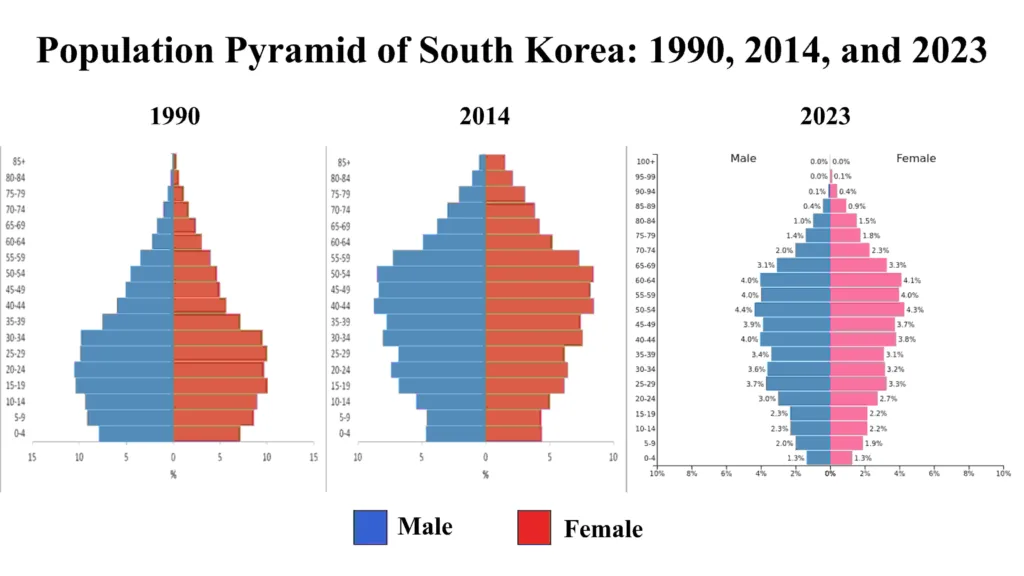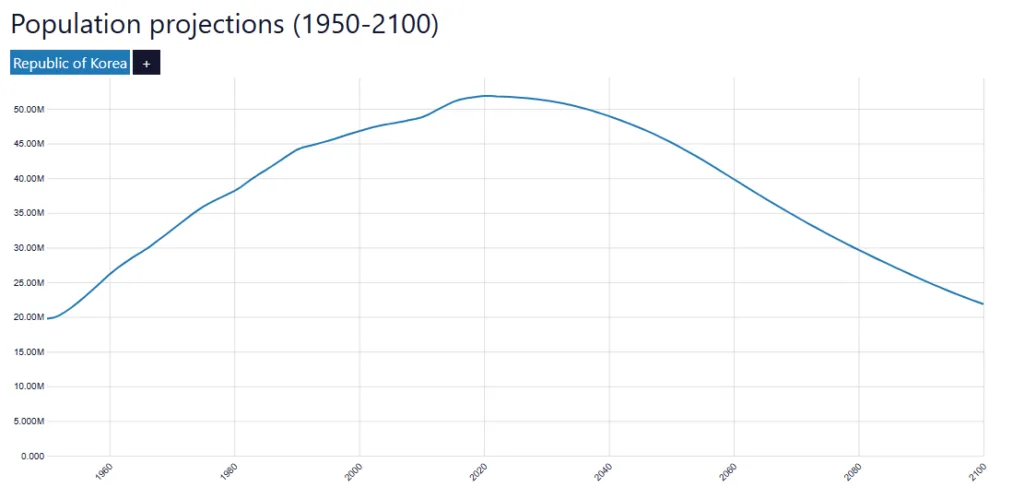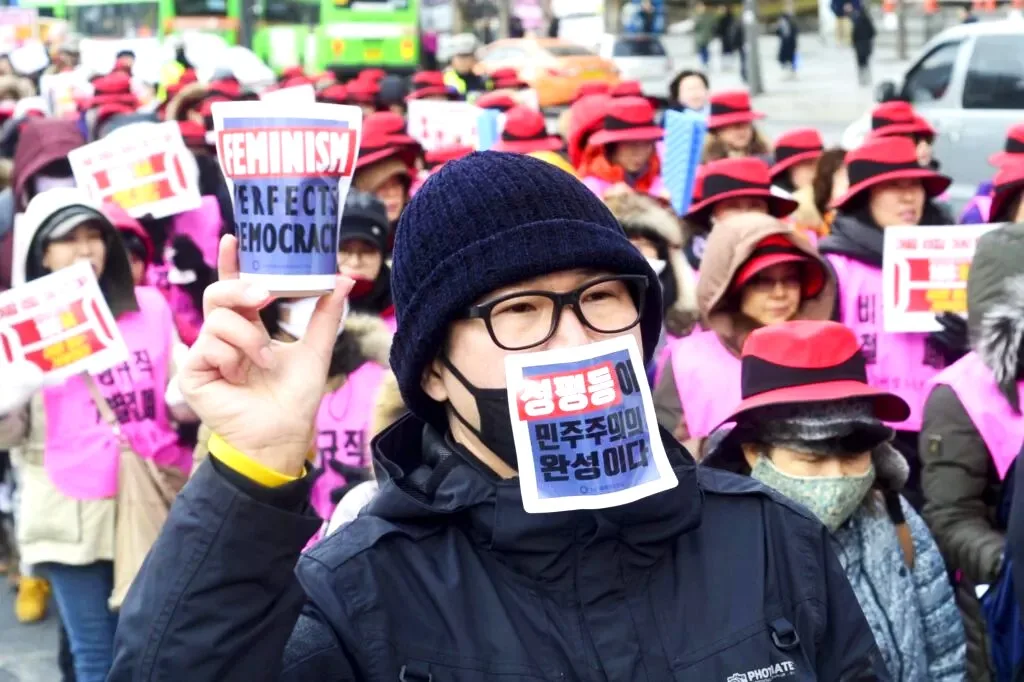Contents
The issue happening in South Korea is the dramatic decline in birth rates. It is not just a drop it is one of the lowest in the world. This has sparked talks about the future of South Korea, and the role of feminism, culture, and government policies in shaping these numbers.
Earlier South Korean families were larger, with females commonly giving birth to several children. But over the decades, things have diverted. Today, many females are choosing not to marry or have kids, and this decision is connected to societal pressures and changing gender dynamics. Feminism has played a major role here, as females fight for equality and independence, challenging traditional roles like staying home to care for children or managing household responsibilities.
This decline in South Korea’s birth rate affects the future workforce, economy, and culture, making it a complex issue that requires serious attention.
The History of South Korea’s Population Changes
A few decades ago, South Korea had a very high birth rate. In the 1960s, it was common for females to have around six children. Families were large, and the population grew steadily. However, the government introduced family planning policies to control this rapid growth.
In the 1970s and 1980s, these policies became tightened, encouraging families to have fewer children. By the 1980s, the average number of children per woman had dropped to two. At the time, the government was focused on economic growth, and smaller families were seen as essential to achieving their goals.
Tracing Demographic Shifts from 1990 to 2023 – The Path to a Top-Heavy Pyramid
- 1990: A Broad Base Pyramid
In 1990, South Korea’s population pyramid displayed a broad base reflecting a high birth rate. The majority of the population comprised children and youth, indicating a rapidly growing younger generation. - 2014: A Narrowing Base Pyramid
By 2014, the base of the pyramid significantly narrowed, highlighting a sharp decline in birth rates. A growing middle-aged population signaled demographic shifts, with fewer young people entering the workforce. - 2023: Current Critical Stage (changing to Inverted Pyramid)
The current population pyramid shows a drastically inverted shape. The aging population dominates while the birth rate plummets to a critically low level. This imbalance threatens economic stability and social welfare systems.
Population pyramid of South Korea

Decades of Decline – South Korea’s TFR and CBR from 1960 to 2030
The table shows the Total Fertility Rate (TFR) and Crude Birth Rate (CBR) for South Korea from 1960 to 2030 by decade. The values for earlier years (1960–2020) are based on historical data, while the 2030 values are projections:
| Year | TFR (Children per Woman) | CBR (Per 1,000 People) |
| 1960 | 6.0 | 42.0 |
| 1970 | 4.5 | 30.0 |
| 1980 | 2.8 | 22.0 |
| 1990 | 1.6 | 15.5 |
| 2000 | 1.3 | 10.9 |
| 2010 | 1.2 | 9.0 |
| 2020 | 0.84 | 5.9 |
| 2030 | 0.7 (forecast) | 4.7 (forecast) |
Population Projections – South Korea’s Demographic Journey from 1950 to 2100
Today the situation is very different. South Korea has the lowest birth rate in the world. The current population is around 52M, but it is expected to decline in the coming decades. Experts believe it could drop to just 17M or even less by the end of the 2100.

There are several reasons for this sharp decline. Women are choosing not to marry or have children, citing societal pressures and traditional expectations. Feminism has also played a big role, as women push back against the idea that their primary role is to bear and raise children.
In order to tackle this issue, the government has tried to introduce incentives such as deferring mandatory military service for men who have three children by the age of 30. But these measures have largely failed because both men and women are unwilling to take on the responsibility of parenting.
This population decline is not just about numbers it reflects changing values, societal expectations, and a need for a better balance between men and women. It is a historical change that will shape the future of South Korea.
The Current Situation and Reasons Behind South Korea’s Birth Rate Decline
South Korea is currently at a critical moment, in 2022, the birth rate was 0.78 and South Korea became the country in the globe to record a fertility rate of less than one kid per female. facing an unprecedented population problem. The following reasons are widely identified across the country.

- Since 2015, South Korea’s “feminism” has reshaped activism, addressing gender issues and demographic challenges. (Ref)
- Families are shrinking and the number of newborns being born is too low to sustain the population.
- Many women are deciding not to get married or have kids due to traditional gender roles and unequal responsibilities.
- The cost of raising children is extremely high and includes expensive education and childcare.
- People feel marriage and raising a family are difficult to balance with work and personal life.
- Government policies offering financial help and childcare support have not solved the problem.
- The issue is connected to societal attitudes gender equality and the quality of life for families.
- The population is aging rapidly and fewer young people are joining the workforce.
- The economy meets challenges as there are fewer workers to support the elderly and social systems.
- Solving the crisis needs societal change and a better environment for families not just policies.
However, it is not that people oppose the idea of children but the lifestyle associated with having a family feels undesirable in today’s society.
This table compares the top five countries with significant declines in Total Fertility Rate (TFR) alongside South Korea’s Birth Rate, which demonstrates the steepest falling trend globally.
| Year/Country | South Korea | China | Thailand | Japan | Italy |
| 1990 | 1.6 | 2.3 | 2.2 | 1.5 | 1.3 |
| 2000 | 1.3 | 1.7 | 1.8 | 1.3 | 1.2 |
| 2010 | 1.2 | 1.6 | 1.5 | 1.4 | 1.4 |
| 2020 | 0.84 | 1.3 | 1.4 | 1.3 | 1.3 |
| 2030 (forecast) | 0.7 | 1.2 | 1.3 | 1.3 | 1.2 |
Efforts to Address the South Korea’s Birth Rate Decline
South Korean government is well aware of the birth rate crisis and tried to address its root causes. Over the years, they have introduced policies and incentives to encourage people to have more kids. However, these actions results have been underwhelming, and the problem continues.
One of the main steps the government has taken is offering financial support to families. Parents receive support to help cover childcare costs, education expenses and even basic living costs for raising a child. In some cases, cash payments are provided for each newborn as an incentive for partners to have more children. However, while these benefits are helpful, they don’t seem to be enough to handle the issues.
So, government has also implemented workplace policies to support working parents. These include expanded parental leave and flexible working hours, aimed at making it easier for partners to balance careers and family life. Unfortunately, societal norms and workplace cultures often prevent parents especially mothers from fully taking advantage of these benefits. Many women still worry career setbacks if they prioritize family over work.
Another controversial policy applied exempting men from mandatory military service if they became fathers of three children before a certain age. While the purpose was to encourage larger families, this measure failed to gain traction. Many men viewed it as impracticable, given that females were not equally motivated to have multiple children due to the burdens of parenting.
The government has also tried to improve gender equality by encouraging participation of women in the workforce and managing the gender pay gap. However, improvement in this area has been slow and societal expectations for females to shoulder the majority of household commitments remain a major barrier.
Despite these efforts, the root causes such as high living costs, long working hours, and outdated gender roles remain unaddressed. Without tackling these deeper cultural and economic issues, government policies alone may not be enough to reverse the decline in South Korea’s birth rate.
Impact of the Birth Rate Decline on South Korea’s Future
The decline in South Korea’s birth rate is more than just a demographic issue it’s shaping the country’s future in significant ways. When I think about what this means for South Korea, I see a nation facing challenges that touch every aspect of society, from its economy to its cultural identity.
One major concern is the retiring workforce. As fewer children are born, there will be fewer young people to replace retiring workers. This creates a domino effect, where fewer workers mean lower productivity, slower economic growth & less innovation. Industries depend on a constant labor supply may struggle to survive and pushing the country into a long economic slowdown.
Another issue is the pressure on social welfare systems. With fewer young taxpayers supporting a growing elderly population funding for pensions and healthcare will become increasingly difficult. This imbalance between the working age population and retirees could lead to higher taxes and reduced benefits, affecting all.
South Korea is known for its rich traditions and healthy family values. As family sizes shrink and marriage rates decline these cultural pillars could weaken. The growing preference for personal lifestyles over traditional family structures may change how people connect and interact within society.
The rural areas are already feeling the effect. Many villages are being abandoned as young people migrate to cities and leaving behind aging communities with little chance of revival. This urban migration further widens the gap between rural and urban development creating regional disparities.
If this trend continues, South Korean global influence could decline. A smaller, aging population may weaken the economic power of South Korea and its ability to compete on the international stage. It is clear that without addressing this crisis, South Korean future could face significant obstacles.
Public Reactions and Global Comparisons
The public in South Korea reacts to the declining birth rate, it is clear that opinions are mixed. Many people feel frustrated especially younger generations. They believe that the high cost of living, intense work culture and lack of support for families make it nearly impossible to consider having children. Others criticize the efforts of the government saying they haven’t done enough to address the root causes of the problem.
Globally, the situation in South Korea is frequently compared to that of countries like Japan and Italy., which also face aging populations due to low birth rates. But, s the decline in South Korea is happening much faster. Countries like Sweden and France have managed to stabilize their childbirth rates through generous parental leave policies and childcare support. It is a reminder that while this is a shared challenge, the solutions can differ widely depending on cultural and economic factors.
So, the reflect on the declining birth rate, it is clear that this issue is deeply rooted in societal, economic and cultural factors. The challenges are complex, from the rise of feminism to changing family dynamics and economic pressures. While the government has made efforts to address the crisis, the results so far have been limited. Without meaningful changes that address people’s real concerns, such as work life balance and affordable childcare, this trend could reshape South Korea’s future in unpredictable ways. It is a critical moment, one that demands innovative solutions and collective effort.
South Korea’s Birth Rate: South Korea’s Demographic Journey from 1950 to 2100
South Korea’s Birth Rate: South Korea’s Demographic Journey from 1950 to 2100, Reasons Behind South Korea’s Birth Rate decline, Impact of the Birth Rate Decline on South Korea’s Future, Population pyramid of South Korea
Here you can find China’s Population Decline and Its Instant Impact

You’ve taken a complex idea and distilled it into something both clear and beautiful.